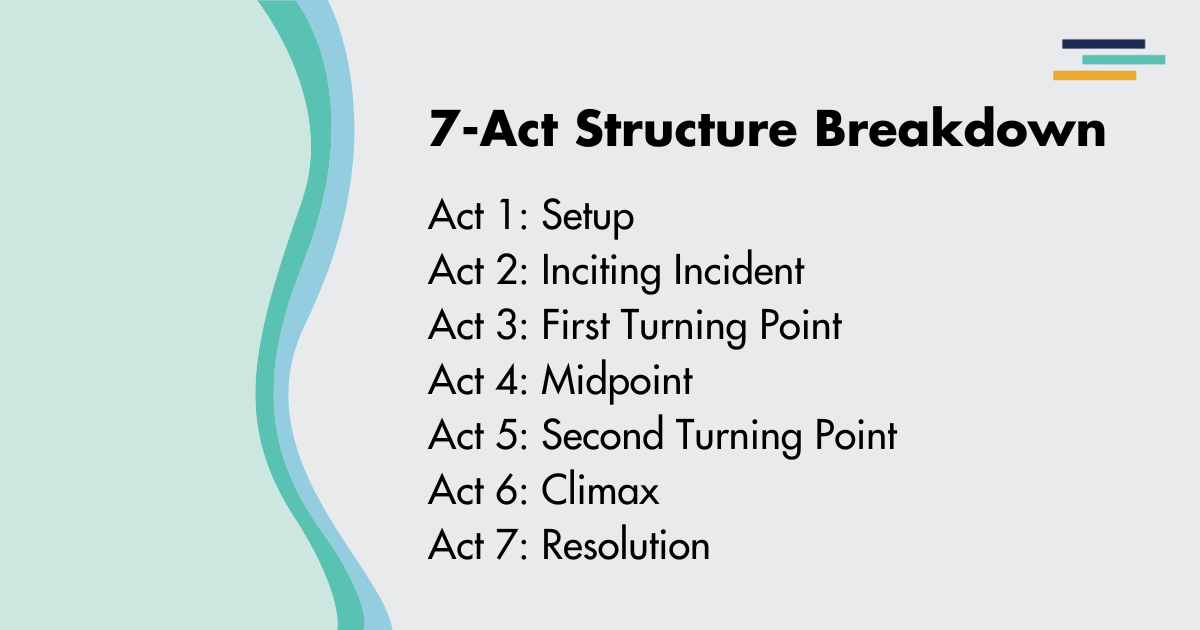
Ever feel like your story needs a little extra structure?
Enter the 7-Act Structure, a plotting method designed to guide you through the highs, lows, and twists that keep readers glued to the page.
If the traditional three-act framework feels too basic, this approach breaks things down even further, providing more guideposts along your narrative journey.
In this article, we’ll dive into what the 7-Act Structure is, its origins, and how you can use it to craft an interesting story. With tips, examples, and a breakdown of each act, you’ll be ready to tackle your next project with newfound clarity.
Take a free trial of Fictionary today and take your story to the next level.
What Is the 7-Act Plot Structure?
The 7-Act Structure is a method for outlining stories that divides the narrative into seven distinct parts, or “acts.”
It builds on traditional plotting methods but offers a more detailed roadmap. Each act has a specific purpose and moves the story forward by ramping up stakes, developing character arcs, and ensuring a solid climax and resolution.
Unlike shorter structures, the seven-act framework gives writers the space to explore character evolution, create suspense, and delve deeper into the emotional core of the story.
It’s often used in screenwriting, but it works just as well for novels, particularly in genres like fantasy, thriller, or mystery, where plot intricacies are key.

Seven Point Story Structure Origin
The 7-Act Structure originated as a method to bring clarity to complex narratives.
While three and five-act structures focus on primary plot beats, the seven-act version developed from the need to explore even more plot depth. It’s especially popular in screenwriting, where each act allows for specific scenes and character moments to breathe.
Screenwriters and novelists alike have turned to the seven-act framework for its ability to balance character development and plot without losing momentum.
Think of it as the storytelling equivalent of a well-paced symphony.
It’s intricate, layered, and offers ample room to explore themes and character journeys.
7 Act Structure Breakdown
Act 1: Setup
The Setup is where you establish your story’s world, main characters, and their status quo.
This act sets the tone and provides a glimpse into the protagonist’s current life, hinting at their goals, desires, and underlying issues.
For readers, the Setup should feel like stepping into a new reality, rich with sensory details that make them want to stay and explore. Use this act to create the emotional groundwork that will soon get disrupted.
During the Setup, introduce your main character’s goals and their immediate obstacles.
Even if they’re living in relative peace, there should be hints of underlying conflicts. Subtle tensions in relationships or looming challenges that will get explored further.
The Setup is also an excellent time to introduce secondary characters who will play significant roles, as well as any societal, environmental, or moral questions that apply to the world you’re building.
The goal?
Make readers care about the protagonist’s world before you upend it.
Act 2: Inciting Incident
The Inciting Incident is the spark that launches your protagonist out of their comfort zone.
This act introduces a specific event that disrupts the protagonist’s life and nudges (or shoves) them into a new reality.
It’s essential that this incident is both surprising and logical.
An unexpected event, yet one that makes perfect sense within the context of the story world.
For example, in a fantasy novel, the inciting incident might be a mysterious stranger with urgent news. In a thriller, it could be the discovery of a clue that reopens an old case.
The Inciting Incident should make the protagonist question their situation and propel them toward the journey ahead. It’s also an opportunity to introduce stakes:
- What might happen if the protagonist ignores this incident?
- What are the risks if they take action?
Act 3: First Turning Point
The First Turning Point is when the protagonist makes a decision that firmly commits them to the journey ahead.
They have encountered a significant obstacle or challenge, which has heightened the tension and stakes of the story. Now, they must make a choice. One that will drive them deeper into the narrative and away from their old life.
This act marks the beginning of the protagonist’s transformation. By making this choice, they are signaling to readers (and to themselves) that there is no turning back.
This turning point should be emotionally charged, highlighting a clash between the protagonist’s goals and the barriers they face. It can be a moment of realization, a confrontation with a rival, or a decision to leave everything behind in pursuit of a larger goal.
It’s the act that truly kicks off Act 4, setting up a deeper, more complex conflict for the protagonist to navigate.
Act 4: Midpoint
The Midpoint is the heart of the story, a pivotal event that changes the protagonist’s perspective.
This moment introduces a revelation, twist, or significant action that adds complexity to the story and challenges the protagonist to adapt. The Midpoint often represents a shift from a reactive to an active approach.
Instead of reacting to events, the protagonist takes charge of their situation.
In this act, the protagonist might gain new insight, form an alliance, or discover a betrayal that reframes the entire story. It’s an opportunity to deepen character development, explore moral or ethical dilemmas, and ramp up the stakes.
The Midpoint isn’t merely a twist. It should also create momentum that propels the narrative into Act 5 with a sense of urgency. This turning point should remind readers that the protagonist is growing, preparing them for the heightened emotional stakes in the acts to come.
Act 5: Second Turning Point
Act 5 is the story’s emotional and narrative low point, often referred to as the “dark night of the soul.”
This is where the protagonist faces their deepest fears, internal struggles, and doubts. The Second Turning Point is a moment of crisis that forces them to confront the consequences of their actions, their limitations, and the reality of what’s at stake.
It’s not just a setback…
It’s a profound moment that shakes the protagonist to their core.
At this stage, the protagonist might be close to giving up, feeling as though the odds are stacked too heavily against them.
This act is critical for establishing the character’s resilience, as it’s often the moment they discover new inner strength or find a renewed sense of purpose.
It’s also an opportunity to explore themes of failure, redemption, or the price of ambition.
Use this act to strip the protagonist down to their core, revealing who they truly are and what they’re willing to fight for.
Act 6: Climax
The Climax is the crescendo of the story, the moment where the protagonist confronts their greatest challenge and the primary conflict comes to a head.
This act is where all the tension, stakes, and character development you’ve built up pay off in a satisfying showdown. The Climax should be a highly emotional, action-packed, or revelatory sequence that resolves the main plot arc and gives readers a sense of closure.
In the Climax, the protagonist must apply everything they’ve learned throughout their journey, drawing on their newfound strength, allies, or wisdom to overcome the antagonist or achieve their goal.
This act should have the highest stakes, putting everything the protagonist values on the line. It’s the culmination of the story’s themes, character arcs, and emotional investment, delivering a payoff that feels both inevitable and surprising.
Act 7: Resolution
The Resolution is where loose ends get tied up, questions get answered, and the protagonist’s journey gets brought to a satisfying close.
This act provides closure, showing how the protagonist and other characters have changed because of the events they’ve experienced. It’s also an opportunity to reinforce the story’s themes and give readers a last glimpse into the protagonist’s life post-conflict.
In some stories, the Resolution might set up a sequel or hint at unresolved mysteries, while in others, it provides a full-circle moment, returning to the initial setting with a new perspective.
The key is to ensure the Resolution feels earned.
Readers should see the consequences of the protagonist’s journey and the impact of the choices they made along the way. Whether it’s a happy ending, a tragic one, or somewhere in between, the Resolution should leave readers with a sense of completion and emotional satisfaction.

Seven-Act Structure Example: The Hunger Games by Suzanne Collins
To see the seven-act structure in action, let’s break down The Hunger Games:
Act 1: Setup
In District 12, we’re introduced to Katniss Everdeen, a young woman who lives in poverty and is the primary provider for her family.
Life is hard in this oppressed district, and Katniss is a skilled hunter who sneaks beyond the district’s boundaries to feed her family. This setup not only establishes her resourcefulness and resilience but also paints a grim picture of life under the Capitol’s oppressive regime.
Katniss’s love for her sister Prim and her struggle to survive lay the foundation for understanding her motivations and sense of loyalty, which will drive her actions throughout the story.
Act 2: Inciting Incident
The Inciting Incident occurs during the annual Reaping, a grim lottery where one boy and one girl from each district get chosen to fight to the death in the Hunger Games.
Katniss’s world gets shattered when Prim’s name gets drawn, a twist that she couldn’t have expected. Driven by love and desperation, Katniss volunteers in her sister’s place, setting her on a new and dangerous path.
This moment is a profound shift for Katniss, forcing her to confront a life-or-death situation. The stakes are now higher than survival…
She must outwit and outlast 23 other tributes.
Act 3: First Turning Point
Upon arriving at the Capitol, Katniss trains for the Games, facing new challenges and opponents.
Preparation, assessments, and strategy mark her time in the Capitol.
She encounters people who could become either allies or enemies, such as her stylist Cinna, her mentor Haymitch, and her fellow tributes, including Peeta. During training, she realizes the deadly seriousness of the Games, understanding that her survival depends not only on her skills but also on how she presents herself to the audience and sponsors.
This is a pivotal shift for Katniss, who grasps the Capitol’s power over her and its citizens through this brutal “entertainment.”
Act 4: Midpoint
The Midpoint marks a significant emotional moment for Katniss: her alliance with Rue, a young tribute from District 11.
Katniss sees a reflection of her sister in Rue, evoking her protective instincts and adding an emotional layer to her fight. Together, they strategize and survive, but the alliance is tragically cut short when Rue gets killed.
Katniss’s mourning and her symbolic gesture of covering Rue’s body in flowers signal a shift from mere survival to quiet defiance against the Capitol.
This act deepens Katniss’s resolve and lays the groundwork for her future rebellion, as her alliance with Rue becomes a turning point in her understanding of the Games’ inhumanity.
Act 5: Second Turning Point
The second turning point occurs with an unexpected rule change announced mid-Games, stating that two tributes from the same district can win if they survive together.
This leads Katniss to seek Peeta, the boy from her district, changing her strategy from individual survival to partnership. This alliance adds complexity to the story, as Katniss grapples with her feelings for Peeta and the Capitol’s manipulation of her public image.
The romantic angle becomes part of her strategy, and she plays to the cameras, knowing that sponsors are crucial to her and Peeta’s survival.
The stakes get intensified as she realizes the Capitol is not just watching but actively shaping their fates.
Act 6: Climax
The Climax of the story takes place as Katniss and Peeta face the last tributes.
The Capitol’s Gamekeepers introduce dangerous creatures to heighten the tension, creating a life-or-death showdown. After an intense battle, Katniss and Peeta outlast the others, standing as the last two survivors.
However, the Capitol reverses the rule change, announcing that only one of them can win.
In a defiant act of rebellion, Katniss suggests they both eat poisonous berries, forcing the Capitol’s hand.
Unable to let both victors die and spoil the Games, the Capitol declares them co-winners. This act of defiance—playing the Capitol’s game yet refusing to follow its rules—cements Katniss as a figurehead of the resistance, setting the stage for future conflicts.
Act 7: Resolution
In the Resolution, Katniss and Peeta return to District 12 as victors, but the victory is bittersweet.
Katniss is conflicted about her relationship with Peeta, knowing some of her actions in the arena were part of her survival strategy. She is also haunted by what she’s seen and done, aware that the Capitol views her defiance with suspicion.
The seeds of rebellion get planted, both within her and among the districts, as her actions in the Games have inspired others. This last act closes her immediate journey but opens the door to the larger struggle against the Capitol, setting the stage for the series’ continuation.

Tips for Using the Seven-Act Structure
Here are some handy tips for making the seven-act structure work in your writing:
Know Your Ending
A clear destination helps guide each act, ensuring that every turn is purposeful. With an ending in mind, you can keep the structure tight and meaningful.
Embrace Your Characters’ Flaws
The seven-act structure allows ample room for character growth. Use this framework to explore your characters’ flaws and the ways they overcome (or succumb to) them.
Pace Your Midpoint Carefully
The midpoint should offer a twist or revelation that changes the game. This act is critical for maintaining reader engagement, so use it to add depth and surprise.
Don’t Overcomplicate Each Act
While seven acts allow for nuance, avoid crowding each section with too many subplots. Keep the focus clear to maintain narrative coherence.
Let Your Climax Shine
The climax is where your story’s tensions come to a head. Use this act to give readers the payoff they’ve been waiting for, whether it’s a thrilling confrontation or a powerful emotional moment.
And finally, always remember that the story comes first. Focus on:
- Creating engaging characters
- Penning interesting plots
- Structuring solid settings
A tool like Fictionary helps you turn your draft into an interesting story readers love. So, with a strong narrative foundation, your writing can truly shine.


